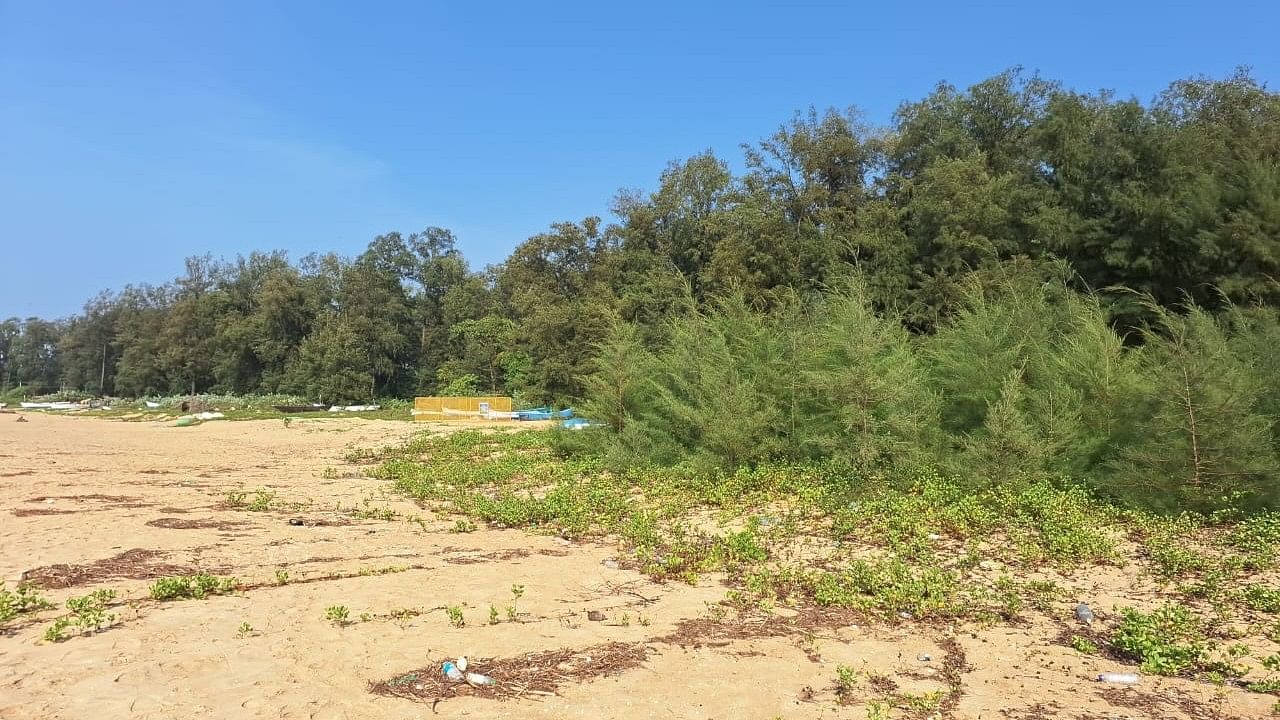
The casuarina saplings (on the right) that were planted recently by the forest department are said to have further shrunk the nesting site at Devbagh Beach near Karwar.
Credit: Special Arrangement.
Hubballi: Depriving the critically endangered Olive Ridley turtles of their nesting ground, around five acres of sandy shore near Karwar have gone "missing".
According to forest officials, the beach near Devbagh Beach Resort eroded due to development works such as construction of breakwaters, a jetty near the port area and the laying of a seawall.
Locals and activists, however, alleged that along with sea erosion, planting of casuarina trees by the forest department over the last year also resulted in the shrinking of the shore.
While forest officials claimed that they did not plant any new saplings near the nesting site, photo evidence provided by the locals showed young saplings on the beach.
Sea erosion and accretion are natural processes. While beaches erode during the monsoon, land accretes in other seasons. While seawalls may prevent erosion in one place, it can result in erosion in other places. Ullal and Panambur beaches near Mangaluru are classic examples of this phenomenon.
A similar problem seems to have hit the beaches near Devbagh.
Dr Annie Kurian, a marine scientist, who has extensively studied sea turtles, said Devbagh beach is a critical nesting site for the Olive Ridleys.
"These turtles are known for natal homing. The hatchlings get geo-magnetic impressions of their place of birth and tend to return to their birthplace to lay eggs. If the nesting site is eroded, then the turtles will be forced to look for alternative sites,” she said.
The coastal areas of Uttara Kannada district from Karwar to Bhatkal are gradually losing several turtle nesting sites due to development works.
Wildlife activist Vikas Tandel said: "Earlier, there was about 50 m to 60 m of sandy beach at Devbagh, which was ideal for turtles to lay eggs. Now, there is hardly 10m to 15m of beach, without a slope, from the high tide line. And next to the beach are recently planted casuarina trees.”
Turtles “recce” beaches before laying eggs. They need an ideal slope, and the right quantity of sand to create a pot-like hole to lay eggs. "With the presence of casuarina trees, which have horizontal roots, the turtles may not find a suitable place to lay eggs,” said V N Nayak, a retired professor of marine biology.
In the last breeding season (December 2022 to March 2023), forest officials recorded the nests of 28 turtles at Devbagh beach and released over 2,000 hatchlings into the sea. This year, officials have recorded only three nesting sites so far at Devbagh but are hopeful of receiving more turtles before March.
Karwar Range Forest Officer Pramodh Bhavikeri acknowledged that due to sea erosion the nesting site's size had reduced. He, however, did not blame the plantation works taken up by the department. "Four to five acres of nesting area near Devbagh have gone missing. Development works like seawall, jetty and breakwaters are the reason for sea erosion," he said.
He refuted the charge that casuarina trees were eating into the nesting site. "No new plantation was done last year. Due to erosion, the distance between the high tide line and the plantation area has reduced,” he said.
Karwar Deputy Conservator of Forests Ravishankar, who took charge recently, said he would look into the reasons for sea erosion after visiting the spot. "It is too early to say if erosion of the beach would affect the nesting pattern of the turtles. We are expecting a higher number of turtles laying eggs in the district.”
P R Naik, manager of the Devbagh Resort, which is operated by the government’s Jungle Lodges & Resorts, said his department did not request the administration for the construction of seawall near the water sports area of the resort. "Compared to last year, the nesting grounds for turtles have shrunk. Sea erosion could be one of the reasons for this."